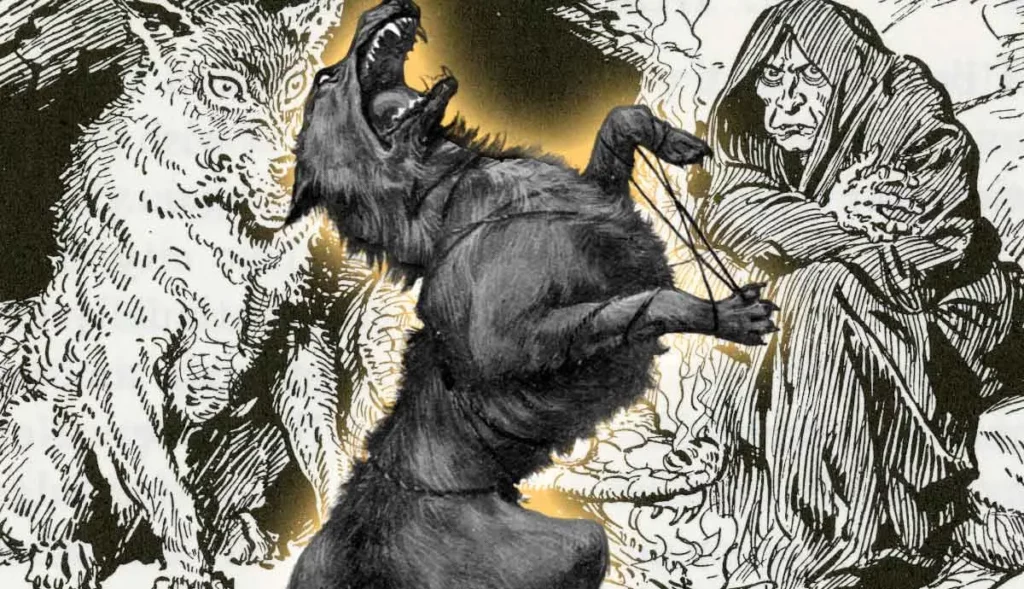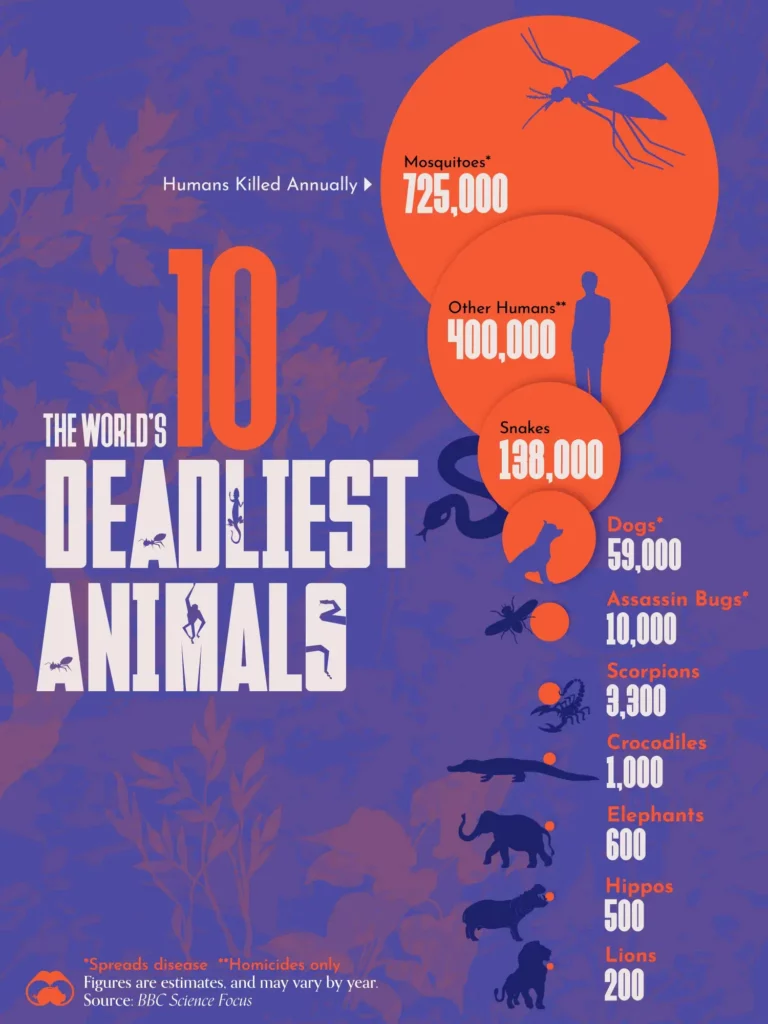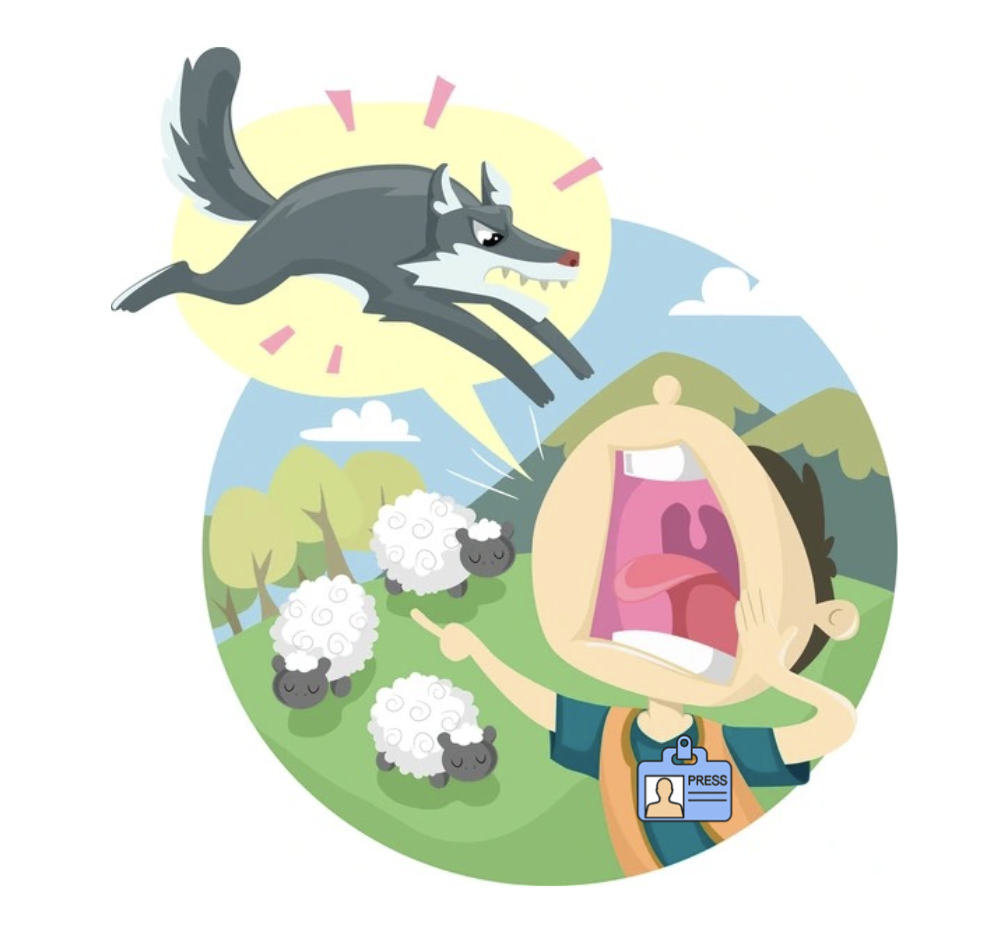
The Myth
Few animals are subject to the bad rep as wolves are. In Norse mythology Fenrir the Wolf dwells the evil “fens” (hence the name) and plays a key role during the events of Ragnarök, where he is foretold to assist in setting the world aflame, resulting in the collapse of humanity and society. The Bible pictures the wolf as a symbol for wicked people (Zephaniah 3:3, Luke 10:3, Acts 20:29, Ezekiel 22:27) and compares false prophets to wolves in sheep’s clothing (Matthew 7:15). The Little Red Riding Hood has kept kids out of the woods for generations, and Disney made sure to keep the stereotype alive by animating The Big Bad Wolf as the ruthless antagonist conniving to eat the cute little farm animals.
Once upon a time these were the stories we were told. But surely as of today, we no longer believe in these fairy tales, do we? Interestingly enough, it seems many of us still do. Let us take a look on why that might be.

Fenrir the Wolf chained by Norse gods – Brittanica
The Evolution
Lupophobia is an evolutionary fear and humans are predisposed to fear wolves. As wolves are predatory animals that hunt in packs, they used to pose a threat to our ancestors, especially at night. Wolves also have many of the qualities that humans are predisposed to fear, such as sharp teeth and claws, as well as size and strength. Fear is designed to promote our survival and our ancestors who feared the wolves may have been more likely to survive, making humans genetically predisposed to a fear of wolves. This predisposition may still result in people being afraid of wolves, regardless of how unlikely it is that they will ever encounter one. Fears and phobias in modern times are rarely rational and might even cloud the understanding of the crucial benefits humans have enjoyed by the wolf evolving to become our best friend [1].
The History
When we still lived as farmers loosing a farm animal, perhaps the only one, to being killed by a wolf, could literarily mean the difference between starving or being able to feed your family. Understandably, farmers feared the wolf and took great precautions to protect their animals from predators. Shepherds never left their animals unguarded, and dogs with herding and alarming behavioural traits were selected for, to help the shepherd round up and protect the animals. The animals were herded to grassy pastures during the day, and herded back to the stables at night. This was often a job for the children, and by the end of the day the children would herd the sheep back to the farm, where they were kept safe in the stable for the night [2].
The Facts
Looking back it is understandable that people were afraid of wolves. We are born with an innate fear and we grow up learning from stories they eat little girls and steal our food. But, how does this apply to todays society? Let us take a look at how dangerous wolves actually are to humans.
Between 2002 and 2020, researchers found 26 fatal attacks throughout the world. Of those 14 were due to rabies. In Europe and North America evidence was only found for 12 attacks (with 14 victims) of which two (both in North America) were fatal, across a period of 18 years. Considering that there are close to 60,000 wolves in North America and 15,000 in Europe, all sharing space with hundreds of millions of people, “it is apparent that the risks associated with a wolf attack are above zero, but far too low to calculate.” – International Wolf Center [3].
Do you know what the worlds most dangerous animal is? It’s the big, bad mosquito! Worldwide mosquitos kill 750 000 humans every year. Next on the list is the human animal, making us the second-deadliest animal for other human beings. Worldwide humans kill 400 000 other humans every year, homicides only. And who do we find on fourth place of the worlds deadliest animal? Oh, if it’s not mans “best friend”, the dog! Worldwide dogs kill 59 000 people every year [4].

Now, let us take a look at the statistics on how deadly wolves are to farm animals. This article will refer to data from Norway, as this is a country with well documented and reliable statistics. It is also a country where the wolf is critically endangered [5].
In Norway 1.9 million lambs and sheep are set free to roam the pastures 5-16 weeks in summertime. Approximately 100 000 sheep and lambs die on pasture from various causes, such as plant poisoning, fly larvae, tick disease, intestinal parasites, accidents in rough terrain, drowning, by getting stuck in broken fences, car collisions, etc. 7% of the sheep and lambs that die on pasture are estimated killed by wild predators [6]. Around 800 – 900 sheep and lambs are killed every year in Norway due to attacks by dogs [7]. Predator attacks receive the most attention, but it is accidents, injuries and disease that cause 85% of the losses. Of those sheep who survive the summer 1,5 million are sent to be slaughtered [8].
Wolves are responsible for 9% of the documented 7% of sheep being killed by wild predators, rounding up to approximately 630 sheep killed by wolves every year in Norway [6]. In the winter of 2023-2024, 74-76 wolves were documented in Norway, of which 42-44 lived in Norway and 32 lived on both sides of the national border with Sweden. In addition, 4 wolves were registered on the move in March, i.e. a total of 78-80 wolves during the registration period [9]. Conclusion: each wolf kills 7,8 sheep every year in Norway.
Who’s afraid of the Big Bad Wolf?
But, the biggest opposers of wolves in Norway are actually not the sheep farmers. These farmers are being subsidised by the government for every sheep they breed, every sheep they slaughter and even every sheep they loose on pasture [10]. This might be a plausible explanation for why there is no longer anyone herding or guarding the sheep and lambs on pasture. Instead, these losses are estimated and budgeted for by the farmer as «normal loss», and paid for by the tax payers [11].
So, who is it that spreads the most hateful posts about wolves in social media, who screams the loudest in pro-con wolf debate panels? Who’s the most afraid of the Big Bad Wolf? The hunter appears to be the most afraid of wolves these days. No-one spews more hate and false information, no-one attacks wildlife protectors with more hatred, and no-one poses more proudly with their gun and a dead wolf. Every year when the application for the wolf hunt is opened, hundreds of hunters apply for a license to kill just a handful of wolves [12].
Many hunters seem to, under the pretence of “wildlife conservation”, wish to eradicate all predators to ensure themselves the right to be the only animal allowed to kill other animals. Yet again, the human animal has proven to be the most dangerous animal on earth, incapable of creating a sustainable relationship to any other living organisms.
Who’s crying wolf?
A study published in 2023 made a survey of Norwegian media coverage on wolves and wether it affected the readers view on wolves. The results showed that the news was dominated by a negative image of an unwanted wolf, and how the reporting had a significant effect on how the readers perceive the wolf as dangerous to both humans and other animals. The media themselves can thus function as an actor in the political debate through their dominant angle and lack of professional neutrality [13].
It seems modern journalism is “crying wolf” for clickbait and is no more fact based than the fairy tales we were told as children. As the media fails to report both sides of the debate, valuable information is often disregarded by the common reader. An example of this is how decimating the numbers of wolves often have the opposite of wanted effect. Big packs of wolves hunt big game and stay away from human populated areas and their animals. Only when we decimate the pack, or kill the teaching parents, the youngsters have to scavenge for food and therefore get closer to human society [14].

Baiting clicks or baiting wolves?
The Future
So, is there a future for wolves in a modern ecology? As 99,9% of all species that ever lived on this planet are already gone extinct, who’s next on the list [15]? Who needs protection the most; the holy sheep or the big bad wolf? Protecting the sheep should be a no-brainer. Even kids managed to do that back in the days. But, how could we protect the wolves? Perhaps the Australian Wildlife Conservation project can give us som inspiration. Their aim is to protect native species by fencing in whole national parks, the biggest one as large as 9390 ha (!). The fence design is of critical importance. It needs to act as a deterrent for invasive predators, but also not stop species inside the fence from moving out, should they choose to do so [16]. Perhaps we could build fences like these around Norwegian National Parks too? Not to keep the wolves out. But to keep them safe inside.
And the wolves lived happily ever after.
The End
The References
[1] https://cpdonline.co.uk/knowledge-base/mental-health/what-is-lupophobia/
[2] https://www.rovdyr.org/aktuelt/barna-som-gikk-i-ura-og-passet-husdyra-mot-bjorn/
[3] https://wolf.org/wolf-info/factsvsfiction/are-wolves-dangerous-to-humans/
[4] https://www.visualcapitalist.com/ranked-top-10-deadliest-animals-for-humans/
[5] https://www.wwf.no/dyr-og-natur/truede-arter/ulv-i-norge
[6] https://www.ssb.no/jord-skog-jakt-og-fiskeri/jordbruk/artikler/beitebruk-og-seterdrift
[7] https://no.wikipedia.org/wiki/Hundebitt
[8] https://www.landbruksdyr.no/fakta/dyr-i-landbruk/sau-i-kjott-og-ullindustri/
[9] https://rovdata.no/ulv/bestandsstatus.aspx
[10] https://rovbase.no/erstatning/sau
[11] https://www.nsg.no/getfile.php/13122728-1551124195/Fylkeslag
[12] https://www.njff.no/hedmark/nyheter/info-om-lisensfelling-av-ulv-utenfor-ulvesona-2023-2024
[13] https://media.wwf.no/assets/attachments/Ulven-i-det-norske-medielandskapet.pdf
[14] https://www.livingwithwolves.org/how-wolves-hunt
[15] https://www.encyclopedia.com/daily/is-it-true-that-99-9-of-all-species-are-extinct/
[16] https://www.australianwildlife.org/conservation-fencing-provides-hope-for-threatened-wildlife/
[17] https://www.ssb.no/jord-skog-jakt-og-fiskeri/jakt/statistikk/aktive-jegere
[18] https://jaktogfiske.njff.no/files/2024/03/01/Skadeskyting%20rovvilt%202014-2023.pdf